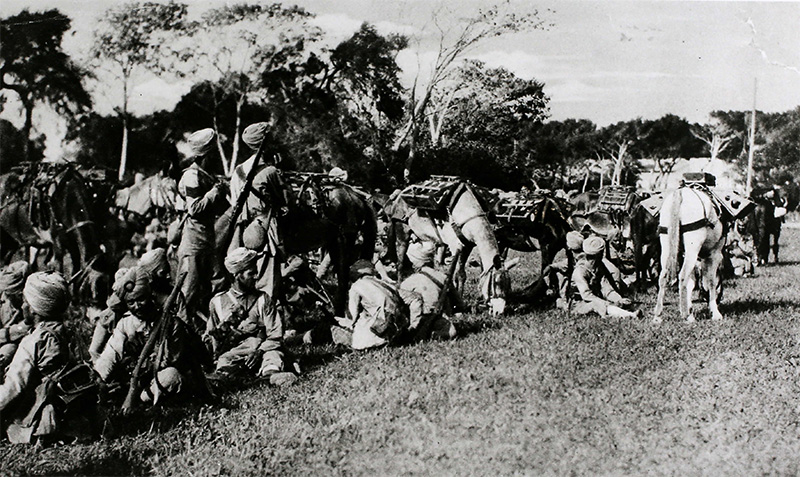India and Britain had stood together in battle many times over the centuries before the Great War came about, but this was the conflict that finally taught the British soldiers to appreciate and respect their Indian ‘brothers in arms’.
To begin with the relationship wasn’t exactly an equal one, but Britain was nonetheless hugely relieved to have India onside. Its own army was comparatively small at that time, with just over 733,000 men available to fight. To that army, India added 223,700 men by October, 75,000 from British units, according to ‘The Western Front Companion’ by Mark Adkin. From 1914 to the war’s end in 1918, the total of British Army made available for deployment, thanks to an outpouring of volunteers and recruits from the home countries and Empire contingents, would number 8,689,467. Of these, over 1.5 million came from the Indian Army.
Initially, 150,000 Regular Army soldiers teamed up with the private armies of Indian princes and the Imperial Service (British) units to form the ‘Army of India’. The forces were arranged so as to leave no doubt who was in charge. In each Battalion there were 12 British Officers, who held the posts of Commanding Officer, Major (or 2nd in command), Adjutant, Quartermaster, and Captains and Lieutenants, all holding the King’s Commission. The Senior Indian Officer, meanwhile, would be the Subedar Major. It was his job to advise the commanding officer on matters relating to the local customs and religions, to prevent misunderstandings. He was backed up by the Subedar, equivalent to a Captain, and Jemaders, equivalent to a Subaltern, commanded the platoons. All of these were Viceroy’s Commissioned Officers. In each Brigade at least one Battalion was always British, as the UK could not yet get over the distrust that had begun with the Indian Mutiny and wanted to keep one eye open at all times.
Within weeks of landing in Marseilles in September 1914 the Army of India soldiers headed for the Front Line, and it wasn’t long before they found themselves in the thick of the fighting in the trenches at Neuve Chapelle. Things weren’t easy for any man on the Front, but the Indian troops suffered more than most. Although they were used to dealing with conditions of extreme heat or cold, and were fit enough to march for miles, the Indian recruits weren’t prepared for the dewy damp of a British winter. In 1914, as many men died from illness as from wounds inflicted by guns or shells. It didn’t help that all their supplies, uniforms and training were intended for conflict in hot climates. Many arrived in light summer uniforms, and were forced to remain in them right through the bitter French winter. There weren’t enough medical supplies to go round, and the Sepoy marksmen were forces to use bolt-action rifles that they weren’t familiar with. Heavy losses decimated their ranks. Many of the British officers, who had largely grown up in India and had at least some understanding of the Indian cultures and dialects, were wiped out. In came completely unfamiliar officers, who had learn what they could about the men and earn their trust over time.

The Indian troops, if they felt aggrieved by their hardships and the fact that they were not accorded equal status with the British troops, never let their feelings affect their actions or enthusiasm on the battlefield. Instead, they fought with great gusto and bravery, with 5 Indian soldiers earning the Victoria Cross in the first year of fighting. Friends and foes alike were impressed; ‘The Western Front Companion’ borrows a quote from a German soldier’s letter from Philip Mason’s ‘A Matter of Honour’:
“We at first spoke with contempt of the Indians. Today we learned to look on them in a different light – the devil knows what the English put into those fellows… with a fearful shouting thousands of those brown forms rushed on us… At a hundred metres we opened a destructive fire which mowed down hundreds, but in spite of that the others advanced… in no time they were in our trenches and truly those brown enemies were not to be despised.”
Apart from anything, the Indian soldiers were some of the best trained in the war. They had been kept active over the decades fighting territorial battles in their homelands, while many of the European armies had seen little fighting. They had a larger pool of professional soldiers to call on than many other nations, and the Indian soldier had more to prove. Despite their high levels of deaths and casualties- the 47th Sikhs, for example, arrived in October 1914 with 764 men, and by the end of November had only 385 fit for duty- the Indians never gave up, and always made their mark in a fight.
They did their bit at Neuve Chapelle, and also at Ypres, the Aubers Ridge, Ypres, Festubert and Loos before the Indian Corps were moved to the Middle East in 1915. Moving them to more familiar climates eased their difficulties considerably. The Indian troops fought on until the end of the war, by which time they had served not only in France, but in Belgium, Gallipolli, Salonika, Somaliland, Cameroon and East Africa, North West Persia and Kurdistan, the Persian Gulf and northern China. In particular, they made their mark in Mesopotamia and Egypt; 138,000 Indian men died on the Western Front, 144,000 in Egypt, and 675,000 in Mesopotamia. Never again would the world under-rate the soldiers of India.

